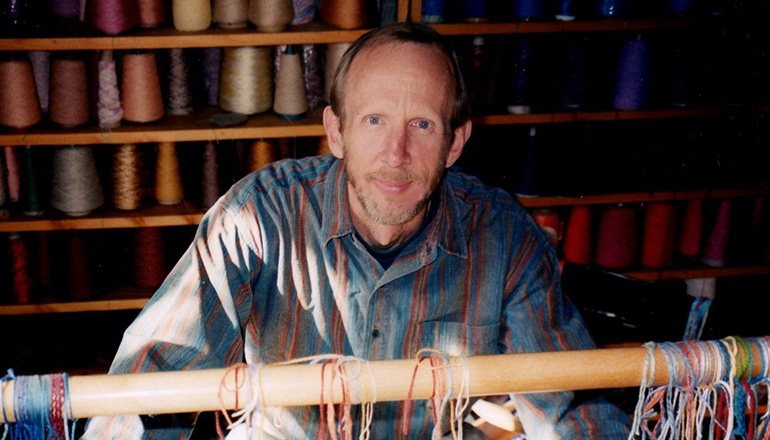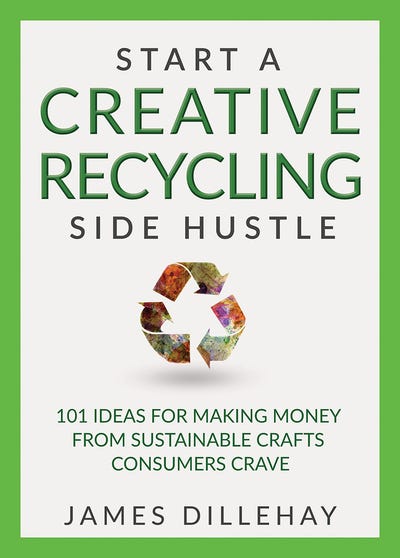Crafter’s Book Uses Gig Economy to Tackle Waste Crisis
Crafter and author James Dillehay discusses his book about tackling waste with the gig economy.

After moving to New Mexico in 1984 to study weaving and fiber arts, crafter and author James Dillehay launched a handmade products business.
“I've sold my work at craft shows, online through Etsy, Amazon and eBay and for a while in my own gallery,” said the Albuquerque, N.M.-based Craftmaker.com author. “My experiences led me to writing and teaching about how to start and grow a craft business.”
In 2015, Dillehay got the idea to repurpose yarn ends that would have gone to landfills into thin, long scarves for women. That product line brought in $134,000. Creating a presentation and online course for the University of Alaska and opening a fine crafts gallery in Madrid, N.M., also led Dillehay to writing his most recently published book, “Start a Creative Recycling Side Hustle: 101 Ideas for Making Money From Sustainable Crafts Consumers Crave.”
Waste360 recently sat down with Dillehay to discuss the book and tackling the waste crisis with the gig economy.
Waste360: How did the idea of the book come about?
James Dillehay: My success marketing my scarf line led me to begin work on a new book for fiber crafters—knitters, weavers, quilters, sewers, etc. Then, I happened to see a cartoon called "Make America Greta Again."
I am not a political activist, but researching Greta Thunberg changed my direction. Love her or hate her, she has brought attention to important issues. I soon found myself questioning whether I was doing enough to help the planet. It seemed that my experiences could help others make a positive impact through repurposing discarded rubbish into arts and crafts consumers buy.
Waste360: What is your goal with the book?
James Dillehay: I believe many people want to make a difference—to help change the culture of "buy and throw away"—but just getting by in life is at the top of their daily to-do list. My goal with the book is to show an earth-friendly plan for how to bring three issues together that can help resolve each other: the world has a trash crisis, consumers want sustainably made products and the average person has challenges making ends meet financially.
Waste360: What are the top five ideas you provide in the book?
James Dillehay: 1. Nearly 90 percent of shoppers around the world are concerned about the environmental impact of their purchases, according to Forbes.
2. Starting a side gig repurposing discarded materials costs very little to get up and running.
3. There are multiple markets for sustainable products. Etsy (the largest site for buying and selling handmade goods) reports a 43 percent increase in buyer searches for "eco-friendly" in all categories, according to MarthaStewart.com. Lyst, an aggregator of fashion trends, says it has seen a 75 percent rise in searches for "sustainable fashion" since 2019.
4. Among the many marketing opportunities described in the book, one of the top skills taught is how to research and use the same words and phrases buyers use to find earth-friendly products on Etsy, Amazon and Google to get more sales online.
5. Getting going with a gig or side business brings challenges like where to start and what to do first. Checklists throughout the book make starting up and growing a creative recycling side hustle easier.
Waste360: How does the book tackle the waste crisis with gig economy?
James Dillehay: Every day, the average American tosses about 4 pounds of trash away that could be recycled, according to the U.S. Environmental Protection Agency. This is free, raw materials for creating easy-to-make products consumers will buy. If you are in the gig economy looking for extra money and want to make a difference, the book spells out multiple opportunities like selling at local craft shows and farmers' markets, on Etsy and Amazon, wholesale to stores and public art programs for larger pieces.

Waste360: Is recycled art popular/profitable? If so, why?
James Dillehay: Yes, but let's get specific because not every recycled product is necessarily in demand. The book shows how to find which products buyers want. For example, recently on Etsy, buyers searched 19,618 times for "recycled sweater mittens," 2,321 times for "recycled art" and 786 times for "recycled metal yard art."
On Amazon, buyers searched 2,310 times for "recycled bracelets for women." And though you might not think of eBay as a market for recycled art or craft items, in a recent 30-day period, 2,387 listings sold that included the search terms "eco-friendly" and "handmade."
As for profitability, your raw materials are basically free. Selling on Etsy costs nothing to set up but a 5 percent seller fee when an item sells. Setting up at farmers’ markets and crafts shows will cost you, but the book gives tips on making those venues pay off. The book also offers pricing formulas so you can determine your profit margins whether selling online, at craft shows or wholesale to stores.
Waste360: What are some of your best-selling pieces made from recycled materials?
James Dillehay: When I started making my scarf line, I used knitting yarn ends that would have gone into the trash. But sales of all colors and styles grew so that I had to buy new yarns to meet the demand. Still, I continued looking for recycled yarns, eventually using recycled silk yarn. The scarves made from those yarns outsold the others.
Before I came out with the scarf line, I sold recycled arts and crafts from different artists and makers in a gallery in Madrid, N.M. The most popular items were jewelry, small statue-like pieces made from repurposed materials and woven scarves I made using more sustainable fibers like bamboo. Recycled women's handbags sold almost as fast as I could put them on display.
Waste360: Where do you get your materials?
James Dillehay: Your recycling bin at home is the first place to look. In my case as a weaver and fiber crafter, I started out with leftover yarn ends that I would have thrown out. Many of the artists and makers whose stories are in the book use free materials gathered wherever trash appears—basically everywhere now. The average person looks around and sees trash but does nothing about it. A creative maker sees material for their next work of art.
Waste360: Where can people get the book?
James Dillehay: The e-book is now in pre-order status on Amazon, Apple, Kobo, Nook and craftmarketer.com. The e-book price is $9.95. The print edition (on recycled paper) will come out mid-March.
My hope is the book will show the way for anyone who wants to make a difference while making a living. It offers a side hustle idea with a balance between sustainability and profitability. I like to think of it as the gig economy meets the circular economy.
About the Author(s)
You May Also Like


